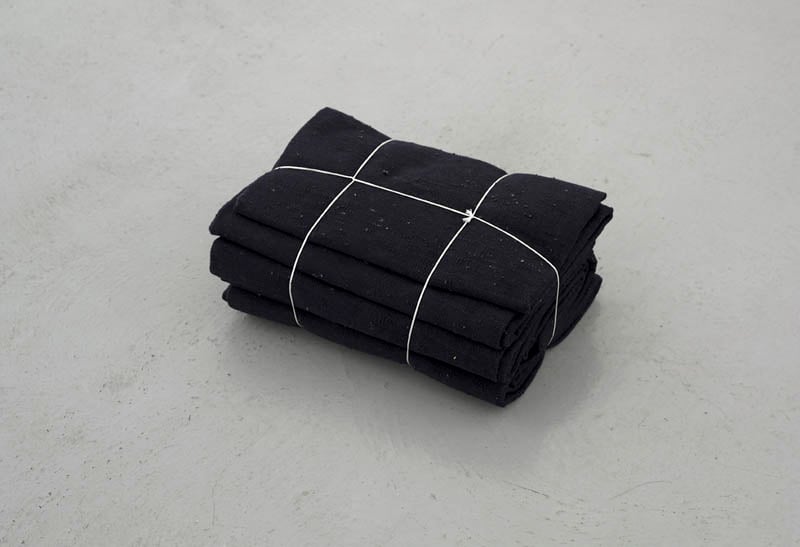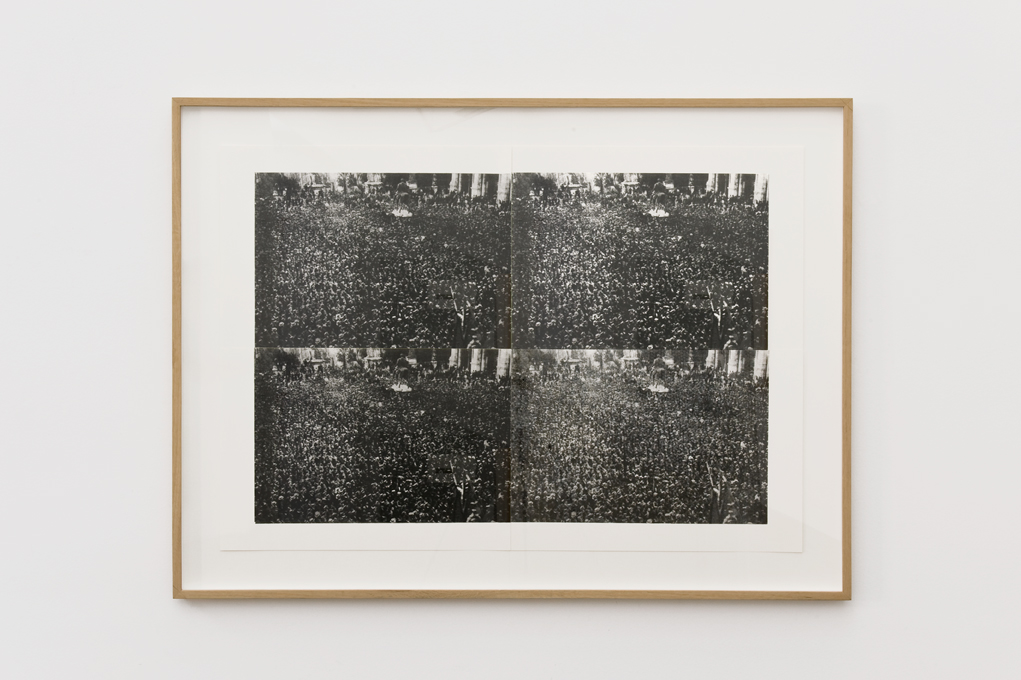
© » KADIST
Todd Hido
The two pieces in the Kadist Collection depict foggy landscapes, one at dawn, the other at nighttime. Both dimly lit scenes are dominated by an eerie feeling. Taken by a road, these painterly photographs suggest the uncanny character of the transient.

© » KADIST
Catherine Opie
Catherine Opie’s candid photograph Cathy (bed Self-portrait) (1987) shows the artist atop a bed wearing a negligee and a dildo; the latter is attached to a whip that she holds in her teeth. Opie is known for her honest portraits of diverse individuals, from LGBT people to football players, and the self-portrait has also been a long-standing and important part of her practice. Instead of hiding her sexuality and interest in sadomasochism, Opie wears it proudly.

© » KADIST
Catherine Opie
Although best known as a provocateur and portraitist, Opie also photographs landscapes, cityscapes, and architecture. The Freeway Series was developed in 1995, right after the artist’s inclusion in that year’s Whitney Biennial. As if suggesting that her work should not be restricted to being seen through overtly political or activist lenses, this series lends insight into the city of Los Angeles via its most characteristic urban feature: its highways.
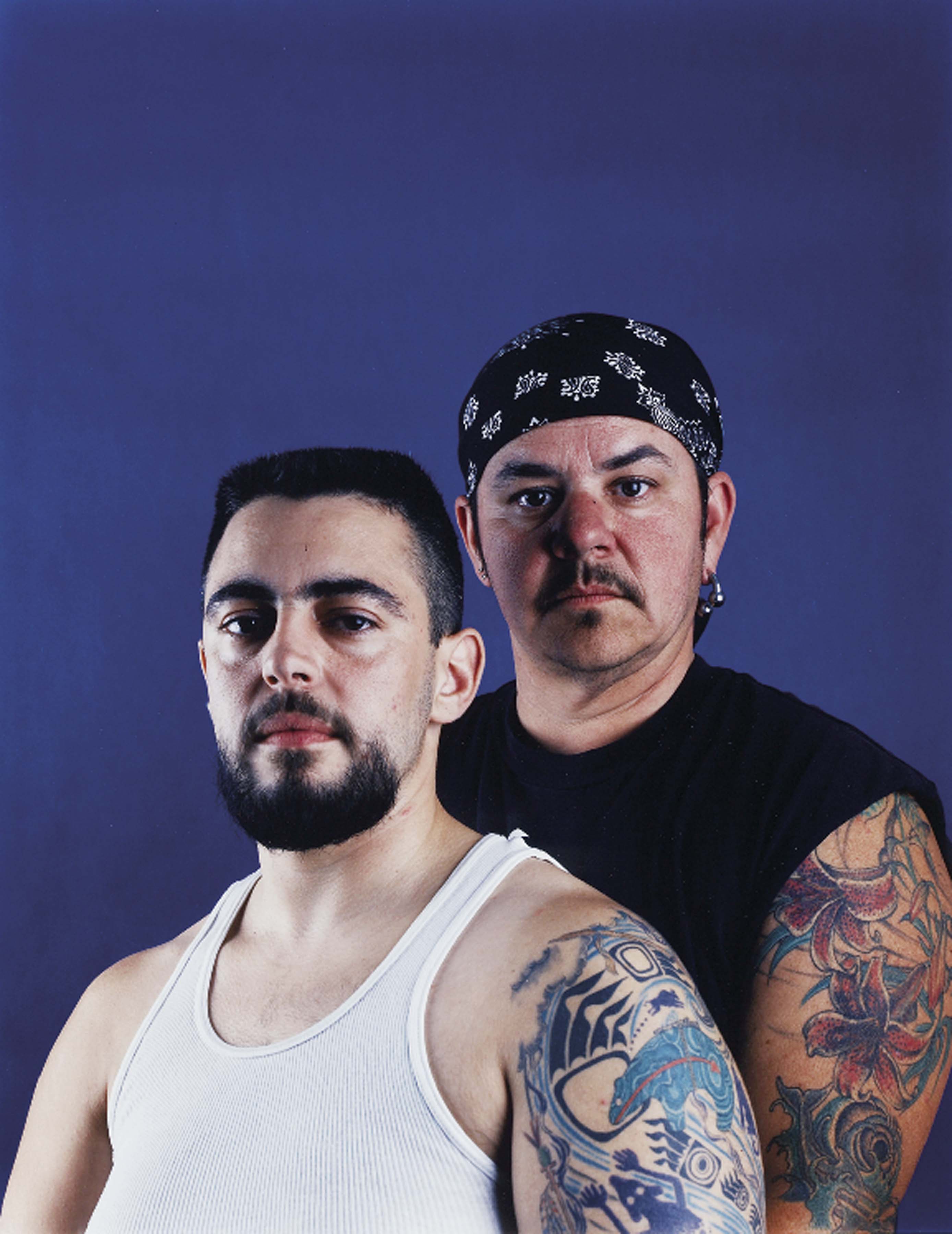
© » KADIST
Catherine Opie
Like many of Opie’s works, Mike and Sky presents female masculinity to defy a binary understanding of gender. The very practice of being photographed raises many complex issues around gender performance and the relationships between an inner self and an outer public persona. Even though Mike and Sky are cropped and obscure one another, many of their choices for self-presentation—as emphasized by their tattoos—remain visible.

© » KADIST
Catherine Opie
Alistair Fate (1994) depicts, presumably, a member of the LGBT community. Catherine Opie is known for her portraits of LGBT, queer, and outsider people; she intends them to come off not as shocking or different, but as human despite their deviance from societal norms. This image is one of several works by Opie in the Kadist Collection that show marginalized people, filtered through the artist’s signature appropriation of formal and classical portraiture in the interest of both documentation and reframing.

© » KADIST
Catherine Opie
In this work, a woman sits on a couch with her shirt pulled up to expose her pierced nipples, which are connected by a chain. She wears an expression of both pleasure and intensity as she points a gun at someone or something outside of the frame. Raven (gun) (1994) is not so much threatening as full of sexuality and potential energy.

© » KADIST
Firenze Lai
Central Station, Alignment, and Sumo are “situation portraits” that present whimsical characters within distorted and troubling worlds. These portraits explore the relationship between the psyche and contemporary social environments, focusing on isolation, identity, and distress. Central Station shows a character reaching to wipe a tear from her face as the blues of her wardrobe seem to blend in with the dismal blue of the background.

© » KADIST
Firenze Lai
Central Station, Alignment, and Sumo are “situation portraits” that present whimsical characters within distorted and troubling worlds. These portraits explore the relationship between the psyche and contemporary social environments, focusing on isolation, identity, and distress. The figure in Alignment slouches with his head in his hands in a gesture of failure or despair, speaking to the difficult task of balancing individual freedom and societal rules.

© » KADIST
Firenze Lai
Central Station, Alignment, and Argument are “situation portraits” that present whimsical characters within distorted and troubling worlds. These portraits explore the relationship between the psyche and contemporary social environments, focusing on isolation, identity, and distress. The two characters in Argument interact in an ambiguous gesture of conflict or embrace as the world around them pulsates in agitated waves.

© » KADIST
Oren Pinhassi
Oren Pinhassi’s work examines the relationship between the human figure and the built environment. His hybrid sculptures, often somewhat emaciated, hover between the figurative and the architectural. In the case of The Crowd , a series of sculptures which evince architectures of control – where humans act and exert power – we find voting booths, segregation cells, institutional desks, places where bureaucratic exchange become spaces of bodily desire, complete with sexual appendages.
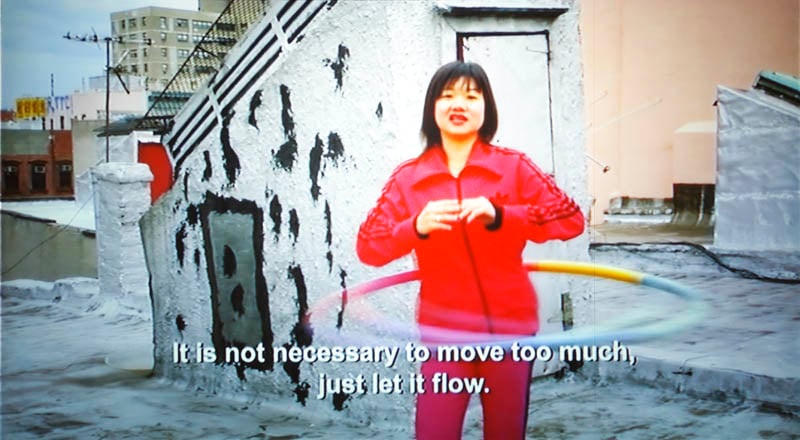
© » KADIST
Christian Jankowski
In New York City’s Chinatown, subject Suat Ling Chua’s morning exercise is to practice the hula hoop. When Christian Jankowski first saw this woman he immediately got the idea to shoot Rooftop Routine . In the short video, Chua leads the group and dictates the movements that each participant has to repeat.

© » KADIST
Fernanda Laguna
Llorar mucho (To Cry A Lot) is representative of Fernanda Laguna’s practice of the past twenty years. It is an upshot of intense emotional stress and psychological regression for the artist, which resulted in her renewed and strengthened commitment to feminist causes, especially in Villa Fiorito, but also as part of the leading committee of Ni Una Menos in Argentina. It also picks up the thread of earlier works, accentuating the use of cotton, and embracing an almost cornily sentimental tone.

© » KADIST
Fernanda Laguna
¡Qué triste estoy! (I’m So Sad) is representative of Fernanda Laguna’s practice of the past twenty years. It is an upshot of intense emotional stress and psychological regression for the artist, which resulted in her renewed and strengthened commitment to feminist causes, especially in Villa Fiorito, but also as part of the leading committee of Ni Una Menos in Argentina.

© » KADIST
Natalia Lassalle-Morillo
La Ruta by Natalia Lassalle-Morillo follows the Panoramic Route, a now weakened infrastructure that meanders through untouched natural landscapes and off-road destinations on the island of Puerto Rico. The Panoramic Route was designed for residents and tourists to connect with the traditional center of the island, as part of a political agenda to modernize the country through infrastructure and social programs. Today, the highway is notorious for dismal road conditions, resulting in isolation between more densely populated metropolitan areas and contributing to a loss of cultural sites and practices that once took place along the Route.

© » KADIST
Himali Singh Soin
Developed especially for the KADIST-KHOJ collaborative exhibition, Frozen World of the Familiar Stranger , Radar Level is set in the world’s last geological minutes, in two ancient landscapes. One in the northern hemisphere in Mongolia at the site of the first dinosaur egg excavation and the other beneath the southern constellation of Nambia, on its old waters. Embedded within the work are a series of dualities and codes.

© » KADIST
Vivian Suter
Vivian Suter paints her canvases and then allows them to come in contact with natural elements. For thirty years she has lived in isolation in the Guatemalan jungle, accumulating canvases, sometimes leaving them out for long periods of time. As a result, Suter does not title or date her paintings.

© » KADIST
Alicia Henry
Out of simple materials, Alicia Henry creates enigmatic, somewhat troubled characters, which reveal her interest in the complexities and the contradictions surrounding familial relationships. The artist probes societal differences and how these variations affect individual and group responses to themes of beauty, the body, and broader issues of identity. Untitled explores these themes and addresses the processes through which women navigate such issues.

© » KADIST
Edgardo Aragón
In the agricultural areas of Mexico, Indigenous people use the mylar magnetic tape unspooled from VHS cassettes as an alternative to the scarecrow—the reflective tape flutters in the wind and does an excellent job scaring birds away from crops. This kind of creative reuse of materials (overproduced and devalued) that flow through the global trade of consumer goods, is especially rich in Mexico and other parts of Latin America. In 2020, during a period of isolation due to Covid-19, Edgardo Aragón unspooled a VHS tape and installed it in his father’s crop of corn for six months.

© » KADIST
Caspar Heinemann
Glorie #7 by Caspar Heinemann is made from cardboard boxes in which the artist received deliveries at home during lockdown, as well as other materials that he uses in an improvisatory way. Initially, Heinemann began this project by wanting to make a series of birdhouses, an interest of his that derived from walking in parks during lockdown, when bird life was so much more present as a result of the reduction in traffic noise and the absence of aircrafts. Though birdhouses may be safe spaces to nurture fledglings, they are also inherently absurd, as human constructs projected onto bird life.

© » KADIST
Jeamin Cha
Jeamin Cha’s essay-film Ellie’s Eye is an extensive examination of the human mind and the effects of new technology, such as chatbots and virtual avatar therapists on the mental health industry. One such avatar, named Ellie, was developed by the University of Southern California’s Institute for Creative Technologies. Ellie has the ability to interpret the user’s emotions through data collected from their speech and physical gestures to indicate psychological distress on a micro-level, which would be imperceptible by a human therapist.

© » KADIST
Michael Landy
H.2. N. Y Skeleton of the Dump revolves entirely around the performance “Homage to New York” (1960), of the Swiss artist Jean Tinguely (1925-1991), during which the machine built by the artist in the gardens of the Museum of Modern Art (MOMA) had to self-destruct itself in 27 minutes, but, in the end, it had to be finished off by firemenbeing called in after it erupted in flames. Since the discovery of Jean tinguely’s retrospective at the Tate Gallery in London, in 1982, Michael Landy spent two years researching and sketching (charcoal, oil, glue, ink) from his previous research carried out at Museum Tinguely in Basel, and at the MOMA in New York.

© » KADIST
Shaun Leonardo
Shaun Leonardo uses his own body to communicate and portray imagery. In his film Bull in the Ring , hyper-masculine images of physicality are staged at the expense of his own physical comfort. The function of the male body has long been a signifier of self-worth and the body affirms and legitimizes feelings of control and agency over environment.
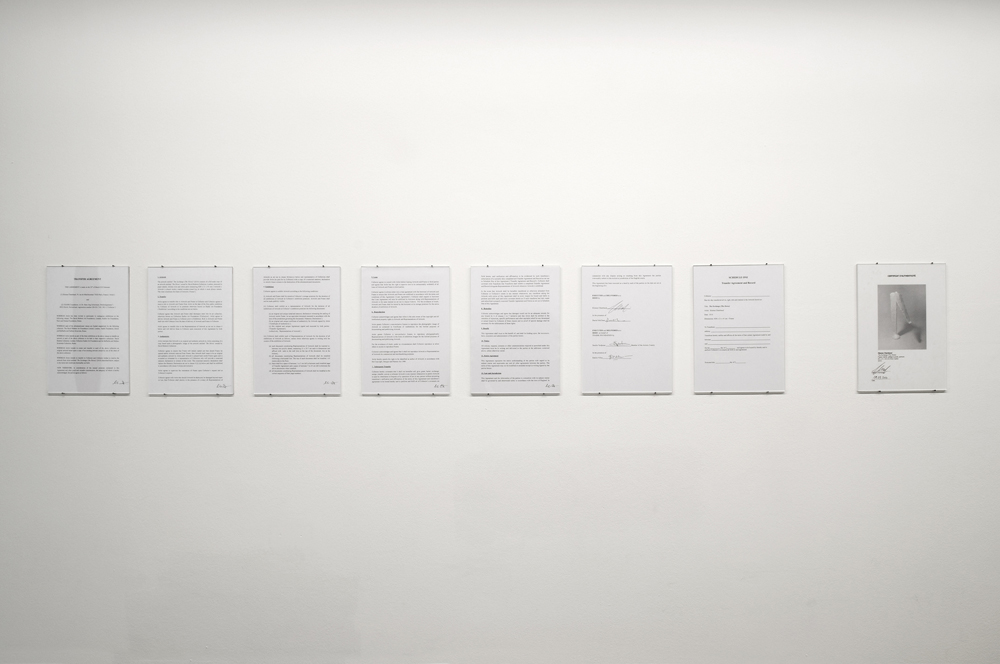
© » KADIST
Étienne Chambaud
Drawing & Print (Drawing & Print)
In 2010, Kadist Art Foundation, David Roberts Foundation and Nomas Foundation successively presented an exhibition of the work of Etienne Chambaud in collaboration with Vincent Normand: The Siren’s Stage / Le Stade des Sirènes. For this project, Etienne Chambaud made The Exchange (The Horse) . A contract was written with the lawyer Daniel McClean to establish the conditions for the exhibition and conservation of copies of the sculptures exchanged between the collections of these three foundations.

© » KADIST
John Isaacs
A child and dreamer my whole life long (broken tree) (2004) is a sculpture made of filler, wire, copper, oil paint, and wood depicting a tree just at it’s moment of breaking into half – one part alive with foliage and blooming branches and the other the crisp of the break exposed, with the trunk adhered solidly to a plinth. The sculpture appears to speak quite bluntly about Isaac’s own sense of bleak pessimism when exposing a severed tree, the universe’s sacred sign of life and birth. Through the perfect rendering of this encapsulated moment, Isaacs demonstrates the strength of the sculptural artifact and his interest in failure and fragility.

© » KADIST
Ellen Lesperance
Somewhere Along the Black Sea in the Distant North-East, or in Libya in the Furthest South, The Amazons – The Woman and the Girls Children – Exist Just Outside of the Range of Normal Human Experience

© » KADIST
Andrea Bowers
Bowers’ Radical Hospitality (2015) is a sculptural contradiction: its red and blue neon letters proclaim the words of the title, signaling openness and generosity, while the barbed wires that encircle the words give another message entirely. Meant to hang from the ceiling, Bowers’ neon is further weighed down by long wind chimes made of aluminum pipes and wooden wind catchers that drip unsteadily from their anchors. Poetic but frantic in its juxtapositions, Bowers’ work captures a certain paradoxical energy that echoes the current political climate—it is hopeful but hindered, cacophonous but well intentioned, uncertain but ominous.

© » KADIST
Aung Ko
They burn our village by Aung Ko is part of the artist’s daily visual diary as an attempt to process and note what has been happening in Myanmar while he is being exiled, following the military takeover of the government in February 2021. Almost two years ago, Myanmar’s military ousted the democratically elected government of Aung San Suu Kyi and seized power in a coup. Since then, the country has descended into turmoil.

© » KADIST
Rodrigo Torres
Drawing & Print (Drawing & Print)
In his Conceito abstrato series, however, Rodrigo Torres turns to the abstract, using the shapes, numbers, lines, and subtle colors of international currencies to create non-representational forms with lavish geometries and baroque curving forms.

© » KADIST
Andrea Bowers
Drawing & Print (Drawing & Print)
The small drawings that comprise Study from May Day March, Los Angeles 2010 (Immigration Reform Now) and We Are Immigrants Not Terrorists are based on photographs taken at a political rally in downtown Los Angeles in which thousands of individuals demonstrated for immigrants’ rights. The protesters and their supporters carried signs and wore t-shirts whose messages are highlighted in the drawings. However, in them, Bowers isolates the images of the protesters from the multitude that surrounds them in the original photographs, and, therefore amplifies their messages.
Catherine Opie
- location: Los Angeles, California
- year born: 1961
- gender: female
- nationality: American
- home town: Sandusky, Ohio
Jonas Bendiksen
Jonas Bendiksen is a Norwegian-American artist and photographer whose work addresses enclaves, people on the fringes of society, and those living in isolated communities...
Joanna Piotrowska
Photographer and filmmaker Joanna Piotrowska explores issues such as the female condition, family dynamics, and post-Soviet Poland, through black and white images that depict the quotidian...
Paolo Cirio
Artist Paolo Cirio engages with legal, economic, and cultural systems of information...
Firenze Lai
Firenze Lai is a Hong Kong painter known for her atmospheric portraits that explore the ways in which contemporary life causes people to adjust to their surrounding conditions in disturbing ways...
Andrea Bowers
- location: Los Angeles, California
- year born: 1965
- gender: female
- nationality: American
- home town: Wilmington, Ohio
Fernanda Laguna
Fernanda Laguna has mobilized and influenced a whole generation of artists through her various projects since the mid-1990s...
Vivian Suter
Vivian Suter was born in Buenos Aires but brought up in Switzerland where she trained to be an artist...
Jeamin Cha
Jeamin Cha’s questions exist in the gyre between individual and social environment, stepping over conspicuous strands of relation between the two in favor of cultivating characters that dwell in the night, under-noticed or otherwise surplus figures outside of mainstream societal representation...
Michael Landy
- location: London, United Kingdom
- year born: 1963
- gender: male
- nationality: British
Caspar Heinemann
Caspar Heinemann is a queer artist and writer who makes work that reflects and represents his gender and identity...
Gyempo Wangchuk
Gyempo Wangchuk is a unique artist in the Bhutanese, and wider Himalayan context because he combines his classical training in traditional Bhutanese painting with contemporary concepts and aesthetics, as well as discreet but potent expressions of dissidence...
Christian Nyampeta
Christian Nyampeta’s works investigate how individuals and communities negotiate forms of socially-organized violence...
Alban Hajdinaj
Alban Hajdinaj creates parallel worlds, fictions from a chaotic context: his generation and his country...
Yangjiang Group
Zheng Guogu founded the artistic group Yangjiang Group in 2002 with Chen Zaiyan (b...
Alicia Henry
Alicia Henry creates work that departs from Western ideas of portraiture, which denote a likeness or a construction of a subject...
Jason Dodge
Jason Dodge extracts objects from everyday life – of which he adds minimal alterations by the way that he isolates and presents them...
Jean Claracq
Jean Claracq uses his work to deal with issues of loneliness in the social media era, depicting scenes of everyday life featuring isolated individuals against broad infrastructures as an evocation of alienation...
Mary Reid Kelley
Drawing from literature, plays, and historical events, Mary Reid Kelley makes rambunctious videos that explore the condition of women throughout history...
Todd Hido
- location: San Francisco, California
- year born: 1968
- gender: male
- nationality: American
- home town: Kent, Ohio
Aung Ko
Aung Ko works with painting, film, installation, and performance...
John Isaacs
John Isaacs’ work encompasses many different media, though much of it has origins in sculpture...
Allen Ruppersberg
- year born: 1944
- gender: male
- nationality: American
- home town: Cleveland, Ohio
Christian Jankowski
- location: Göttingen, Deutschland
- year born: 1968
- gender: male
- nationality: German
Chen Zhexiang
CHEN Zhexiang is a digital media artist and director of animation...
Ellen Lesperance
Ellen Lesperance begins with archival footage of various activist events throughout history...
Rodrigo Torres
Brazilian artist Rodrigo Torres has been deconstructing international paper currencies to form intricate collages of color, line, shape, and texture for several years...
Anna Boghiguian
Anna Boghighian makes drawings and paintings of individuals and urban spaces as well as being a writer and a poet...
Oren Pinhassi
Oren Pinhass’s practice integrates architecture and sculpture in the making of fantastical forms, employing found objects as well as replicating such objects in various media...
Christiane Baumgartner
Christiane Baumgartner’s practice is related to her origins...

© » AESTHETICA
about 3 months ago (02/11/2024)
Aesthetica Magazine - A Space Between Worlds A Space Between Worlds For Taysa Jorge, art is a bridge...
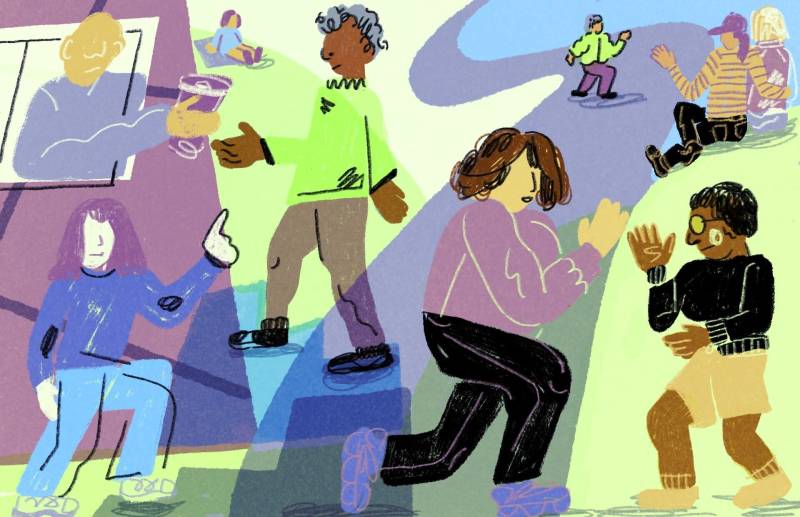
© » KQED
about 4 months ago (12/16/2023)
Breaking Isolation and Building Bridges | KQED Skip to Nav Skip to Main Skip to Footer Rightnowish Breaking Isolation and Building Bridges Listen Pendarvis Harshaw Marisol Medina-Cadena Dec 15 Save Article Save Article Failed to save article Please try again Facebook Share-FB Twitter Share-Twitter Email Share-Email Copy Link Copy Link The art of building bridges in the community...

© » ROYAL ACADEMY
about 7 months ago (10/05/2023)
Video: Catherine Opie on photographing leading British artists | Blog | Royal Academy of Arts Catherine Opie in the RA Collection Gallery Video: Catherine Opie on photographing leading British artists Read more Become a Friend Video: Catherine Opie on photographing leading British artists Published 8 September 2023 Catherine Opie discusses her portraits of David Hockney, Anish Kapoor, Gillian Wearing, Isaac Julien and Lynette Yiadom-Boakye, featured in our free display in the Collection Gallery...

© » LARRY'S LIST
about 19 months ago (10/05/2022)
“Ordinarily, I feel a sense of solidarity in isolation with other artists...

© » ARTS EQUATOR
about 26 months ago (03/02/2022)
WINDOW by ATTEMPTS: A click away | ArtsEquator Skip to content Who is SARA? Cheryl: There’s a SARA that me and Rei talked about, when we were just bouncing ideas...
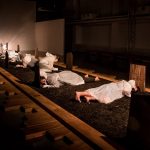
© » ARTS EQUATOR
about 35 months ago (06/28/2021)
The Body Witness: Gardens Speak, en route, As Far As Isolation Goes at SIFA 2021 | ArtsEquator Thinking and Talking about Arts and Culture in Southeast Asia ArtsEquator Viewpoints Arts House Limited June 28, 2021 By Vithya Subramaniam (1,600 words, 6-minute read) Though cancelled last year amid the developing pandemic, Singapore International Festival of Arts has done well to lean into the possibilities of small-group, distanced programmes for this year’s line-up...
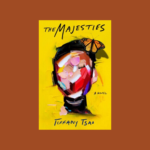
© » ARTS EQUATOR
about 48 months ago (05/14/2020)
Reading in isolation: Tiffany Tsao’s The Majesties | ArtsEquator Thinking and Talking about Arts and Culture in Southeast Asia Americas May 14, 2020 By Kathy Rowland (760 words, 4-minute read) This review may contain spoilers...
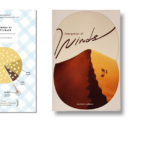
© » ARTS EQUATOR
about 49 months ago (04/09/2020)
Reading in isolation: ‘Others’ is Not a Race and Interpreter of Winds | ArtsEquator Thinking and Talking about Arts and Culture in Southeast Asia Articles April 9, 2020 By Kathy Rowland (913 words, 4-minute read) Last November, when there was nary a thought for social distancing, and Corona conjured up visions of lime wedges and grimy bars, I reread Rex Shelley’s 1991 debut novel, The Shrimp People ...

© » ARTS EQUATOR
about 59 months ago (07/08/2019)
Migrant Ecologies Project: A Grain of Wheat Inside a Salt Water Crocodile | ArtsEquator Thinking and Talking about Arts and Culture in Southeast Asia Grain of Wheat July 8, 2019 Artist letters, clockwise from top left: Letters from Mari Keski Korsu, Marietta Radomska, Lee Weng Choy and Filippa Ramos...

© » ARTS EQUATOR
about 59 months ago (07/08/2019)
Migrant Ecologies Project: A Grain of Wheat Inside a Salt Water Crocodile | ArtsEquator Thinking and Talking about Arts and Culture in Southeast Asia Grain of Wheat July 8, 2019 This is our box and our seed in its current resting place inside Mine 3 Platåberget Svalbard, Arctic Circle...

© » ARTS EQUATOR
about 59 months ago (07/08/2019)
Migrant Ecologies Project: A Grain of Wheat Inside a Salt Water Crocodile | ArtsEquator Thinking and Talking about Arts and Culture in Southeast Asia Grain of Wheat July 8, 2019 The interior of the crocodile photographed at the then-Raffles Museum of Biodiversity in 2013...

© » ARTS EQUATOR
about 59 months ago (07/08/2019)
Migrant Ecologies Project: A Grain of Wheat Inside a Salt Water Crocodile | ArtsEquator Thinking and Talking about Arts and Culture in Southeast Asia Grain of Wheat July 8, 2019 Inside the mine with the Migrant Ecologies Project box, with project conceptualiser Dr...

© » ARTS EQUATOR
about 59 months ago (07/08/2019)
Migrant Ecologies Project: A Grain of Wheat Inside a Salt Water Crocodile | ArtsEquator Thinking and Talking about Arts and Culture in Southeast Asia Grain of Wheat July 8, 2019 The one grain we were able to find in the wheat from inside the crocodile was inside this husk, now buried inside the mountain in Svalbard...

© » ARTS EQUATOR
about 59 months ago (07/08/2019)
Migrant Ecologies Project: A Grain of Wheat Inside a Salt Water Crocodile | ArtsEquator Thinking and Talking about Arts and Culture in Southeast Asia Grain of Wheat July 8, 2019 The artist’s book is the main artistic contribution of the Project...

© » ARTS EQUATOR
about 59 months ago (07/08/2019)
Migrant Ecologies Project: A Grain of Wheat Inside a Salt Water Crocodile | ArtsEquator Thinking and Talking about Arts and Culture in Southeast Asia Grain of Wheat July 8, 2019 The artists outside Mine 3 of Platåberget Mountain, in a moment of silence with their boxes in the goodbye ceremony to the exhibition...

© » ARTS EQUATOR
about 59 months ago (07/08/2019)
Migrant Ecologies Project: A Grain of Wheat Inside a Salt Water Crocodile | ArtsEquator Thinking and Talking about Arts and Culture in Southeast Asia Grain of Wheat July 8, 2019 Letter from Harriet Rabe Von Froelich...

© » ARTS EQUATOR
about 59 months ago (07/08/2019)
Migrant Ecologies Project: A Grain of Wheat Inside a Salt Water Crocodile | ArtsEquator Thinking and Talking about Arts and Culture in Southeast Asia Grain of Wheat July 8, 2019 A biscuit tin formerly containing Mermaid Brand Cream Crackers with wheat designs on the outside was chosen as the box to house the wheat as well as test tubes of salt, needles and Singapore’s very own NEWater – all for the wheat’s ritual protection...

© » ARTS EQUATOR
about 59 months ago (07/08/2019)
Migrant Ecologies Project: A Grain of Wheat Inside a Salt Water Crocodile | ArtsEquator Thinking and Talking about Arts and Culture in Southeast Asia Grain of Wheat July 8, 2019 The 4.7m concertina artists book: A Guide to the Interior of a Salt Water Crocodile by Zachary Chan and Lucy Davis with photographs by Kee Ya Ting, June 2019...
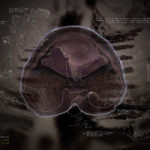
© » ARTS EQUATOR
about 59 months ago (07/08/2019)
Migrant Ecologies Project: A Grain of Wheat Inside a Salt Water Crocodile | ArtsEquator Thinking and Talking about Arts and Culture in Southeast Asia Grain of Wheat July 8, 2019 Wheat Grain World Dreams , the centre section from the artist’s book contains a map that includes some of our research questions around, for example, histories of 19th century cash crops and the crimes of the British India Company; and the extension of China’s Belt and Road journey West...

© » ARTS EQUATOR
about 59 months ago (07/08/2019)
Migrant Ecologies Project: A Grain of Wheat Inside a Salt Water Crocodile | ArtsEquator Thinking and Talking about Arts and Culture in Southeast Asia Grain of Wheat July 8, 2019 The first known image of the crocodile, shot in 1887 at the mouth of the Serangoon River...
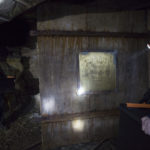
© » ARTS EQUATOR
about 59 months ago (07/08/2019)
Migrant Ecologies Project: A Grain of Wheat Inside a Salt Water Crocodile | ArtsEquator Thinking and Talking about Arts and Culture in Southeast Asia Grain of Wheat July 8, 2019 After what seemed like a long walk in silence and darkness into the mountain we came to an almost mythological-looking door with the words ‘Fröhall’ – seed room – written upon it...

© » ARTS EQUATOR
about 59 months ago (07/08/2019)
Migrant Ecologies Project: A Grain of Wheat Inside a Salt Water Crocodile | ArtsEquator Thinking and Talking about Arts and Culture in Southeast Asia Grain of Wheat July 8, 2019 Our neighbour, the Svalbard Global Seed Vault, was under reconstruction during our time in Norway in order to make the vault more resilient against melting glaciers and water leakage...
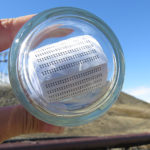
© » ARTS EQUATOR
about 59 months ago (07/08/2019)
Migrant Ecologies Project: A Grain of Wheat Inside a Salt Water Crocodile | ArtsEquator Thinking and Talking about Arts and Culture in Southeast Asia Grain of Wheat July 8, 2019 For the benefit of the possible intelligences that may find these treasures after humans have long gone, we have translated one of the photographs of our wheat gleaning ceremony in Singapore into binary code...
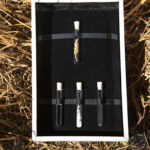
© » ARTS EQUATOR
about 59 months ago (07/08/2019)
Migrant Ecologies Project: A Grain of Wheat Inside a Salt Water Crocodile | ArtsEquator Thinking and Talking about Arts and Culture in Southeast Asia Grain of Wheat July 8, 2019 A biscuit tin formerly containing Mermaid Brand Cream Crackers with wheat designs on the outside was chosen as the box to house the wheat as well as test tubes of salt, needles and Singapore’s very own NEWater – all for the wheat’s ritual protection...
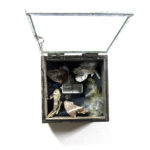
© » ARTS EQUATOR
about 59 months ago (07/08/2019)
Migrant Ecologies Project: A Grain of Wheat Inside a Salt Water Crocodile | ArtsEquator Thinking and Talking about Arts and Culture in Southeast Asia Grain of Wheat July 8, 2019 This is the second resin eye that was inside the crocodile (the first is in the NUS Museum)...

© » ARTS EQUATOR
about 59 months ago (07/08/2019)
Migrant Ecologies Project: A Grain of Wheat Inside a Salt Water Crocodile | ArtsEquator Thinking and Talking about Arts and Culture in Southeast Asia Grain of Wheat July 8, 2019 Zachary Chan and Muhammad Faisal Bin Husni in a ritual ‘wheat gleaning ceremony’ in Singapore...

© » ARTS EQUATOR
about 59 months ago (07/08/2019)
Migrant Ecologies Project: A Grain of Wheat Inside a Salt Water Crocodile | ArtsEquator Thinking and Talking about Arts and Culture in Southeast Asia Grain of Wheat July 8, 2019 Part of a letter from Stephane Rennesson...

© » ARTS EQUATOR
about 59 months ago (07/08/2019)
Migrant Ecologies Project: A Grain of Wheat Inside a Salt Water Crocodile | ArtsEquator Thinking and Talking about Arts and Culture in Southeast Asia Grain of Wheat July 8, 2019 We included 60 letters by leading artists and writers in Southeast Asia and beyond, addressed to the grain of wheat...

© » ARTS EQUATOR
about 65 months ago (12/17/2018)
'Maaf Senin Tutup': 1998 through eclectic eyes of Anggun Priambodo (via The Jakarta Post) | ArtsEquator Thinking and Talking about Arts and Culture in Southeast Asia ArtsEquator Radar December 17, 2018 Anggun Priambodo’s latest exhibition is framed under the guise of a fictional character he created for his last movie of the same name, Maaf Senin Tutup (Sorry, Closed on Mondays) — an artist named Eva who is trying to establish herself in the art world with her first solo exhibition...
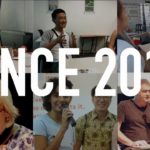
© » ARTS EQUATOR
about 66 months ago (11/15/2018)
ArtsEquator Turns Two! | ArtsEquator Thinking and Talking about Arts and Culture in Southeast Asia ArtsEquator Viewpoints November 15, 2018 ArtsEquator is two years old today! 🎉 Aside from our original reviews, essays, podcasts and visual essays, we’ve also organised programmes to strengthen performance criticism and critical discourse....
-
1970-1979
Allen Ruppersberg
1970Untitled (City Limits) is a series of five black-and-white photographs of road signs, specifically the signs demarcating city limits of several small towns in California...
-
1980-1989
Catherine Opie
1987Catherine Opie’s candid photograph Cathy (bed Self-portrait) (1987) shows the artist atop a bed wearing a negligee and a dildo; the latter is attached to a whip that she holds in her teeth...
Catherine Opie
1987In this work, a woman sits on a couch with her shirt pulled up to expose her pierced nipples, which are connected by a chain...
-
1990-1999
Catherine Opie
1993Like many of Opie’s works, Mike and Sky presents female masculinity to defy a binary understanding of gender...
Catherine Opie
1994Although best known as a provocateur and portraitist, Opie also photographs landscapes, cityscapes, and architecture...
-
2000-2009
John Isaacs
2004A child and dreamer my whole life long (broken tree) (2004) is a sculpture made of filler, wire, copper, oil paint, and wood depicting a tree just at it’s moment of breaking into half – one part alive with foliage and blooming branches and the other the crisp of the break exposed, with the trunk adhered solidly to a plinth...
Christiane Baumgartner
Drawing & Print
2006(Drawing & Print) Baumgartner’s own excursion into war imagery is the diptych Formation ...
Jason Dodge
2007In Algeria, Djidjiga Meffre has woven a fabric with a string, a length equal to the distance from the earth to troposphere...
Christian Jankowski
2008In New York City’s Chinatown, subject Suat Ling Chua’s morning exercise is to practice the hula hoop...
Jean-Luc Moulène
2009Head Box by J ean-Luc Moulène i s not the representation of a space but a real space that remains in the domain of sculpture which the artist develops in parallel with his photographic practice...
-
2010-2019
Étienne Chambaud
Drawing & Print
2010(Drawing & Print) In 2010, Kadist Art Foundation, David Roberts Foundation and Nomas Foundation successively presented an exhibition of the work of Etienne Chambaud in collaboration with Vincent Normand: The Siren’s Stage / Le Stade des Sirènes...
Andrea Bowers
Drawing & Print
2010(Drawing & Print) The small drawings that comprise Study from May Day March, Los Angeles 2010 (Immigration Reform Now) and We Are Immigrants Not Terrorists are based on photographs taken at a political rally in downtown Los Angeles in which thousands of individuals demonstrated for immigrants’ rights...
Leung Chi Wo and Wong Sara
2010Photojournalist with Two Cameras restages a portrait of a photojournalist from the background of an old photograph of protest published in South China Morning Post on January 10, 2010 under the headline “Return of the Radicals: Recent angry protests are nothing new.” The photojournalist in the photograph, probably from a protest of earlier decades, was capturing the scene of a protester’s arrest while wearing two cameras...
Clément Rodzielski
Drawing & Print
2011(Drawing & Print) These photographs are installation shots of the exhibition De A à B, de B à P at Bielefelder Kunstverein (13 November 2010-30 January 2011)...
Yangjiang Group
Drawing & Print
2012(Drawing & Print) One Day in the Mountain is a bilingual calligraphic performance piece written in ink superimposed with food leftover from a meal...
Asier Mendizabal
2012Rotation presents the image of a crowd, a re-appropriation of 19th or beginning of 20th century photographs published in newspapers and magazines...
Sebastián Díaz Morales
2012Pasajes I is the first in a series of Sebastián Díaz Morales’s four videos Pasajes , which focuses on a solitary man walking through Buenos Aires...
Köken Ergun
2012The Battle of Karbala was a military engagement that took place on 10 Muharram, 61 AH (October 10 th , 680) in Karbala, situated in present day Iraq, when Hussein, the grandson of the prophet Muhammad, was killed...
Dineo Seshee Bopape
2012Interested in the collection of object and their potential to evoke various emotional reactions in the audience, Bopape’s “Why do you call me when you know I can’t answer the phone” is an invitation into the limitless netherworld of the unsaid and unspoken...
Firenze Lai
2013Central Station, Alignment, and Sumo are “situation portraits” that present whimsical characters within distorted and troubling worlds...
Firenze Lai
2013Central Station, Alignment, and Sumo are “situation portraits” that present whimsical characters within distorted and troubling worlds...
Firenze Lai
2013Central Station, Alignment, and Argument are “situation portraits” that present whimsical characters within distorted and troubling worlds...
Mary Reid Kelley
2013Priapus Agonistes by Mary Reid Kelley and Patrick Kelley is the first work in The Minotaur Trilogy (2013-2015), a trio of videos that reimagine the Greek myth of the Minotaur...
Anna Boghiguian
2014In the painting called “The Consciousness of Memory, Time, and Guilt” as in many of her recent works, the body is fragmented...
Sebastián Díaz Morales
2014In Suspension a young man is hanging in the air, falling, or perhaps drifting through time and space...
Andrea Bowers
2015Bowers’ Radical Hospitality (2015) is a sculptural contradiction: its red and blue neon letters proclaim the words of the title, signaling openness and generosity, while the barbed wires that encircle the words give another message entirely...
Joanna Piotrowska
2015This selection of untitled photographs taken between 2014 and 2019 focus on Joanna Piotrowska’s long-term preoccupation with issues of domesticity and containment...
Joanna Piotrowska
2015This selection of photographs taken between 2014 and 2019 focus on Piotrowska’s long-term preoccupation with issues of domesticity and containment...
Joanna Piotrowska
2015This selection of photographs taken between 2014 and 2019 focus on Piotrowska’s long-term preoccupation with issues of domesticity and containment...
Himali Singh Soin
2016Developed especially for the KADIST-KHOJ collaborative exhibition, Frozen World of the Familiar Stranger , Radar Level is set in the world’s last geological minutes, in two ancient landscapes...
Rodrigo Torres
Drawing & Print
2016(Drawing & Print) In his Conceito abstrato series, however, Rodrigo Torres turns to the abstract, using the shapes, numbers, lines, and subtle colors of international currencies to create non-representational forms with lavish geometries and baroque curving forms....
Yuri Ancarani
2016The Wedding is a silent film, a probing observation of marriage rituals in Qatar in which we soon notice that there is not a single woman visible...
Nohemí Pérez
Drawing & Print
2016(Drawing & Print) A rich and isolated region, El Catatumbo is located near the border with Venezuela...
Gyempo Wangchuk
2016The various distinct but connected lineages of Himalayan painting remain thriving languages employed by artists from across the region to express their unique perspective in our shared contemporary world...
Fernanda Laguna
2017Llorar mucho (To Cry A Lot) is representative of Fernanda Laguna’s practice of the past twenty years...
Jean Claracq
2017View From an Apartment features 18-year-old Joland Novaj whose image was taken from Instagram...
Fernanda Laguna
2018¡Qué triste estoy! (I’m So Sad) is representative of Fernanda Laguna’s practice of the past twenty years...
Natalia Lassalle-Morillo
2018La Ruta by Natalia Lassalle-Morillo follows the Panoramic Route, a now weakened infrastructure that meanders through untouched natural landscapes and off-road destinations on the island of Puerto Rico...
Christian Nyampeta
2018The film Sometimes It Was Beautiful by Christian Nyampeta poetically addresses the systemic conditions leading and emerging from the 1994 Rwandan genocide, which had lasting and profound effects on Rwanda and neighbouring countries like Congo...
Alicia Henry
2019Out of simple materials, Alicia Henry creates enigmatic, somewhat troubled characters, which reveal her interest in the complexities and the contradictions surrounding familial relationships...
Joanna Piotrowska
2019This selection of photographs taken between 2014 and 2019 focus on Piotrowska’s long-term preoccupation with issues of domesticity and containment...
-
2020-2029
Oren Pinhassi
2020Oren Pinhassi’s work examines the relationship between the human figure and the built environment...
Edgardo Aragón
2020In the agricultural areas of Mexico, Indigenous people use the mylar magnetic tape unspooled from VHS cassettes as an alternative to the scarecrow—the reflective tape flutters in the wind and does an excellent job scaring birds away from crops...
Jeamin Cha
2020Jeamin Cha’s essay-film Ellie’s Eye is an extensive examination of the human mind and the effects of new technology, such as chatbots and virtual avatar therapists on the mental health industry...
Paolo Cirio
2020Capture is a photographic series by Paolo Cirio in which the artist sourced 1000 public images of police officers’ faces and processed them with facial recognition technology...
Paolo Cirio
2020Capture is a photographic series by Paolo Cirio in which the artist sourced 1000 public images of police officers’ faces and processed them with facial recognition technology...
Paolo Cirio
2020Capture is a photographic series by Paolo Cirio in which the artist sourced 1000 public images of police officers’ faces and processed them with facial recognition technology...
Jonas Bendiksen
2021For his project Book of Veles artist Jonas Bendiksen travelled to the small city of Veles in North Macedonia, inspired by a series of press reports starting in 2016, that revealed Veles as a major source of the fake news stories flooding Facebook and other social media sites celebrating Donald Trump and denigrating Hillary Clinton...
Jonas Bendiksen
2021For his project Book of Veles artist Jonas Bendiksen travelled to the small city of Veles in North Macedonia, inspired by a series of press reports starting in 2016, that revealed Veles as a major source of the fake news stories flooding Facebook and other social media sites celebrating Donald Trump and denigrating Hillary Clinton...
Jonas Bendiksen
2021For his project Book of Veles artist Jonas Bendiksen travelled to the small city of Veles in North Macedonia, inspired by a series of press reports starting in 2016, that revealed Veles as a major source of the fake news stories flooding Facebook and other social media sites celebrating Donald Trump and denigrating Hillary Clinton...
Jonas Bendiksen
2021For his project Book of Veles artist Jonas Bendiksen travelled to the small city of Veles in North Macedonia, inspired by a series of press reports starting in 2016, that revealed Veles as a major source of the fake news stories flooding Facebook and other social media sites celebrating Donald Trump and denigrating Hillary Clinton...
Jonas Bendiksen
2021For his project Book of Veles artist Jonas Bendiksen travelled to the small city of Veles in North Macedonia, inspired by a series of press reports starting in 2016, that revealed Veles as a major source of the fake news stories flooding Facebook and other social media sites celebrating Donald Trump and denigrating Hillary Clinton...
Jonas Bendiksen
2021For his project Book of Veles artist Jonas Bendiksen travelled to the small city of Veles in North Macedonia, inspired by a series of press reports starting in 2016, that revealed Veles as a major source of the fake news stories flooding Facebook and other social media sites celebrating Donald Trump and denigrating Hillary Clinton...
Jonas Bendiksen
2021For his project Book of Veles artist Jonas Bendiksen travelled to the small city of Veles in North Macedonia, inspired by a series of press reports starting in 2016, that revealed Veles as a major source of the fake news stories flooding Facebook and other social media sites celebrating Donald Trump and denigrating Hillary Clinton...
Chen Zhexiang
2021In the video work Any Resemblance is Coincidental , CHEN Zhexiang mined portraits of real Asian criminals that were abandoned on the Internet...
Caspar Heinemann
2022Glorie #7 by Caspar Heinemann is made from cardboard boxes in which the artist received deliveries at home during lockdown, as well as other materials that he uses in an improvisatory way...









